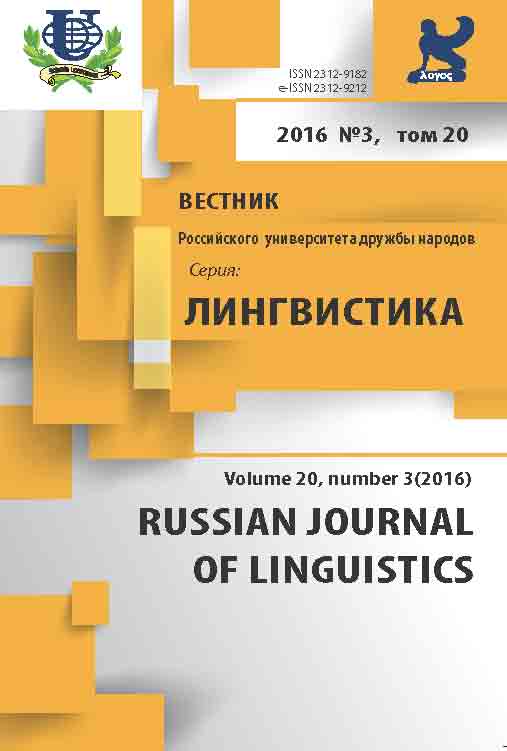Pragmatic Aspects of Quotation in Spanish Media Texts
- Authors: Terentieva E.D.1
-
Affiliations:
- Peoples’ Friendship University of Russia
- Issue: Vol 20, No 3 (2016)
- Pages: 43-56
- Section: Articles
- URL: https://journals.rudn.ru/linguistics/article/view/14739
- ID: 14739
Cite item
Full Text
Abstract
This paper examines the pragmatic functions of citation specific to the Spanish media texts. The texts for analysis were chosen among the so-called national quality press, including El País, El Mundo, and ABC 2014-2016. The study combined the interpretive text analysis and elements of the comparative and contextual analyses. The role of mass media in molding public opinion, and as one of the most powerful instruments of social control cannot be overemphasized. In addition to awareness-raising and influence functions, citation is widely used in media text to bring more credibility and expressiveness to the transmitted information. Presumably, all texts cited in media can be divided into two categories. On the one hand, these are texts that are socially significant and relevant at a specific point in time, and on the other hand, these are so-called precedent texts repeatedly reproduced within a given community. Based on the analyzed material the following three key pragmatic functions can be distinguished: substitution, illustration and reasoning which allows to make both direct and indirect quotation, that differ graphically in terms of the presence or absence of quotation marks, the object of study. Characteristics specific to the implicit citation are treated separately where implicit citation covers the citation of precedent texts used primarily for language game, and thus performs stylistic and advertising functions. The accomplished analysis of the citation pragmatic aspects of Spanish press brings clarity to some of the mechanisms used to impact the reader and shape public opinion.
About the authors
Ekaterina Dmitrievna Terentieva
Peoples’ Friendship University of Russia
Email: terentyeva_ed@pfur.ru
10/2, Miklukho-Maklaya Str., 117198, Moscow, Russia
References
- Алещанова И.В. Газетный текст как разновидность массово-информационного дискурса [Электронный ресурс] // Языковая личность: институциональный и персональный дискурс: Сборник научных трудов: 1 / Волгоградский государственный педагогический университет. 2000. URL: http://zavantag.com/docs/427/index-2017733.html?page=9 (дата обращения: 13.03.2016)
- Арутюнова Н.Д. Диалогическая цитация (к проблеме чужой речи) // Вопросы языкознания. М., 1986. № 1. С. 50-64
- Бахтин М.М. Проблемы поэтики Достоевского // Собр. соч. в 7 т. Т. 6. М., 2002, С. 7-300
- Бициган Д.Д. Цитация в англоязычной рецензии // Вестник МГОУ «Лингвистика». 2011. № 2. С. 7-13
- Блинова О.А. О стилистическом потенциале несобственно-прямой речи в газетном тексте // Вестник МГЛУ. 2010. № 596. С. 136-146
- Варченко В.В. Цитатная речь в медиа-тексте. Изд. 2-е. М.: Книжный дом «ЛИБРОКОМ». 2012. 240 с
- Волошинов В.Н. Марксизм и философия языка. Л., 1929. 188 с
- Волынец Ю.П. Анализ современных исследований цитации в медиадискурсе // XXI век: Итоги прошлого и проблемы настоящего плюс. Пенза, 2015. № 6. С. 213-217
- Гусев С.С. Цитирование как способ аргументации // Речевое общение и аргументация. Санкт-Петербург, Экополис и культура. 1993. Вып. 1. С. 68-76
- Иванова И.П. Цитата как средство стратегии доказательства в немецком публицистическом дискурсе // Вопросы современной науки и практики. Общественные науки. 2015. № 3. С. 116-122
- Клушина Н.И. Языковые механизмы формирования оценки в СМИ [Электронный ресурс] // Публицистика и информация в современном обществе / Под ред. Г.Я. Солганик. 2000. URL: http://www.gramota.ru/biblio/magazines/gramota/28_79 (дата обращения: 13.03.2016)
- Красных В.В. Виртуальная реальность или реальная виртуальность? (Человек. Сознание. Коммуникация). М., 1998. 352 с
- Кулешова А.В. Цитация как ключевой элемент «чужого слова» во французской прессе // Вестник МГПУ. Серия: Филология. Теория языка. Языковое образование. 2014. № 4. С. 62-68
- Леонтьев А.А. Психолингвистические особенности языка СМИ // Язык СМИ как объект междисциплинарного исследования. Учебное пособие. М., МГУ, 2003. С. 66-88
- Ломов А.М. Чужая речь в письменном тексте // Вестник Балтийского федерального университета им. И. Канта. 2012. № 8. С. 31-36
- Саблина М.В. Классификация цитат в аспекте категории системности (на материале текстов современных российских газет) // Мир науки, культуры, образования. Горно-Алтайск, 2010. № 6-2. С. 58-60
- Сметанина С.И. Медиа-текст в системе культуры (динамические процессы в языке и стиле журналистики конца ХХ века). СПб. 2002. 384 с
- Терентьева Е.Д. Скрытая цитация как разновидность цитации в испанской прессе // Инновационное развитие современной науки. Уфа, 2014. С. 201-205
- Ferraz Martínez, Antonio. (2011). El lenguaje de la publicidad. Arco Libros - La Muralla, S.L
- Frías Lebrón, María Trinidad. (2012). Sobre las formas de reproducción del discurso ajeno en algunos textos periodísticos de la prensa italiana y española // Philologia Hispalensis. Vol. 26. № 3-4. Universidad de Sevilla. 121-153
- Guerrero Salazar. (2007). Susana. La creatividad en el lenguaje periodístico. Ediciones Cátedra
- Hurtado González, Silvia. (2003). El uso del lenguaje en la prensa escrita. Universidad de Valladolid
- Libro de estilo de El País. Aguilar, 2014
- Lledó, Eulàlia. (2013). Cambio lingüístico y prensa: problemas, recursos y perspectivas. Laertes Editorial, S.L
- Maldonado, González (1999). Concepción. Discurso directo y discurso indirecto // Gramática Descriptiva de la Lengua Española. Madrid, 3549-3595
- Reyes, Graciela. (1996). Los procedimientos de cita: citas encubiertas y ecos. Madrid, 2ª ed
- Reyes, Graciela. (1995). Los procedimientos de cita: estilo directo y estilo indirecto. Madrid, 2ª ed
Supplementary files















